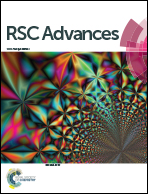Effect of annealing atmosphere on quaternary chalcogenide-based counter electrodes in dye-sensitized solar cell performance: synthesis of Cu2FeSnS4 and Cu2CdSnS4 nanoparticles by thermal decomposition process†
Abstract
The synthesis of stoichiometrically controlled quaternary chalcogenide nanoparticles through a simple, eco-friendly process is still a great challenge. Herein, earth-abundant quaternary chalcogenide nanoparticles, Cu2FeSnS4 (CFTS) and Cu2CdSnS4 (CCdTS), were synthesized via the thermal decomposition of metal precursors. The prepared CFTS and CCdTS films were used as alternative counter electrodes (CEs) in dye-sensitized solar cells (DSSCs). The effects of the annealing atmosphere on morphology, elemental composition, electrical properties and electrochemical catalytic activity of the CFTS and CCdTS films were investigated. Energy dispersive spectroscopy, Hall measurements, cyclic voltammetry, and electrochemical impedance spectroscopy analysis demonstrate that the sulfurized CFTS and CCdTS-based CEs are more efficient for tri-iodide reduction as compared to the N2-annealed CFTS and CCdTS-based CEs. The photoconversion efficiencies (PCEs) of DSSCs fabricated with sulfurized, annealed in N2 atmosphere CFTS and CCdTS as CEs are found to 7.36 ± 0.00%, 5.78 ± 0.12% and 7.12 ± 0.08%, 5.30 ± 0.00% respectively, while the DSSCs fabricated with conventional Pt-based CEs show an efficiency of 8.15 ± 0.09%. These results indicate that the annealing atmosphere of the CEs has an impact on the DSSCs performance.



 Please wait while we load your content...
Please wait while we load your content...